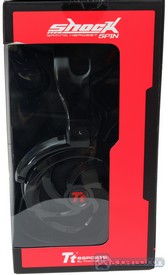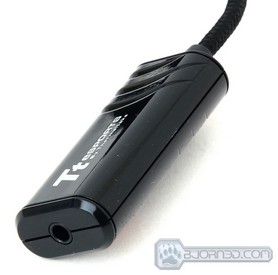The Thermaltake Spin headset is a good general-purpose headset. It provides comfort and quality. Read on to find out more.
INTRODUCTION
The Thermaltake Tt eSports line is oriented for gaming enthusiasts that seek comfort in entertainment. Previously, we had the pleasure to take a look at two of the Tt eSports headsets: the Shock and Shock One. Both headsets demonstrated outstanding comfort while providing a decent auditory experience with 40mm drivers. Today, we will take a look at a completely different headset with a slightly larger 50mm driver. The advantage of having a larger driver directly impacts the quality of the sound, making it more realistic. In addition, the frequency differentiation, which seemed to be somewhat an issue in 40mm driver, should be better, making a better and crisper sound.

The Thermaltake Shock Spin currently is the only headset in the Tt eSports line with 50mm Neodymium drivers and comes in three colors: shining white, diamond black, and royal red. All three headsets come at a rather affordable price of $64.99 on Newegg.com, with the red one costing as low as $60.99. The cushioning around the drivers is made from velvet, as was previously observed in Shock One, and is designed to provide comfortable experience even after hours of gameplay. While our expectations of the headset are rather high, let’s take a closer look in order to see if this headset is truly worth the price.
FEATURES
Neodymium magnet speaker– 50mm oversized driver gaming headset with ass enhancement performance.
Microphone box– independent microphone box: plug& play for quick communication with your team mates.
In-line volume controller– external in-line volume controller for immediate volume adjustment.
Ergonomic shaped velvet cushion– provides long-hour comfort with no constructive feelings.
Multimedia player compatible– compatible with multimedia device with 3.5mm connector.
Specifications
Pictures & Impressions
The Tt eSports Shock Spin headset comes in the slick and classy packaging similar to that of other Thermaltake headsets. The symbolic contrast of red and black as well the logo on the front and black clearly indicate that the product is delivered by Thermaltake. The front of the packaging reveals a sneak peak at the product as well as briefly provides basic product information, such as features. The left side of the packaging expands on the specifications of the headset. Finally the back reveals any additional information that a consumer might find helpful. Note that the microphone box is separate from the headset, and the in-line controller can only control the volume of the headset and not the mic.
After unpacking the product it is clear that the set is well-placed within the box, eliminating any possibility of damage during transportation. The headset, controller and microphone can be seen attached to the front of the supporting structure, while the warranty and instruction manual are attached in the back.
The in-line volume controller as well as microphone box are fairly simple and easy to use. Both items are made compatible to fit into a 3.5mm audio input and output port on the computer. The in-line controller is made to serve as a cable extension for the headset, and as well as the microphone has a 3 ft. long cable. As we had previously mentioned, the microphone is separate from the headset and is equipped with a clip in order to attach to shirts. The only control available for the microphone includes an on/off switch.
While the controller and the microphone of Thermaltake Shock Spin headset proved to be rather simplistic, the headset clearly draws attention. The headset is comprised of multiple composites in order to provide maximum comfort to the consumer. Instead of using the 12 point adjustment system which was previously observed in Shock One and Shock headset, the Shock Spin utilizes a flexible adjustment system. The cushioning around the 50 mm driver is made from velvet in order to provide maximum comfort. However the earpad appears to be significantly larger and is clearly designed to give more room for the ears. Aside from the comfort the larger size is anticipated to provide deeper and higher quality of sound, which we’ll be testing shortly.
Testing & Methodology
While there are no benchmarks that are specifically designed to test headsets, nor it is possible to observe performance by either recording the sounds or looping the sound back into a benchmark program, the testing performed on this headset has been done using a recording program, while running 13 tracks at different frequencies in order to assess the sound production capabilities. Additional factors like comfort, sound isolation, and fullness of sound were taken into consideration, along with the basic response to varying frequencies and the change in performance as the result of equalization. We also tested in order to see just how well this headset holds up in the gaming settings. Noise escape, or the amount of sound that escapes the headphone has also been determined in order to see how much of the sound is actually able to reach those around you.
|
Test Rig |
|
| Case | In-Win Dragon Rider |
| CPU |
Intel Core i7 930 @ 3.8GHz |
| Motherboard |
GIGABYTE G1. Sniper |
| RAM |
Kingston HyperX T1 Black Edition 12 GB DDR3 @1600 Mhz |
| CPU Cooler | Thermalright True Black 120 with 2x Noctua NF-P12 Fans |
| Drives |
3x Seagate Barracuda 1TB 7200.12 Drives RAID 5 |
| Optical | ASUS DVD-Burner |
| GPU |
GIGABYTE Radeon HD 6990 |
| Fan Controller | NZXT Sentry LXE |
| Case Fans |
3x Noctua NF-P12 Fans – Side 3x In-Win 120mm Fans – Front, Back, Top |
| PSU |
SeaSonic X750 Gold 750W |
| Mouse | Cyborg RAT 7 |
| Keyboard | Thermaltake Meka G1 |
| Headset |
Thermaltake Shock Thermaltake Isurus Thermaltake Shock One Thermaltake Shock Spin Sony MDRV600 Sony 7509HD |
Since Thermaltake Spin headset is the first 50mm neodymium that we will be testing, we have decided to test the improvement in frequency response as well as production quality in comparison to other 40 mm neodymium headset like Thermaltake Shock and Sony MDRV600.
Specifications Comparison
Thermaltake Shock 
| Interface | 3.5mm |
|---|---|
| Driver unit | 40mm |
| Frequency Response | 20 Hz-20kHz |
| Impendance | 32 ohm |
| Sensitivity | 114+/- 4 db |
| Max. Input | 100mW |
Sony MDRV600
| Interface | 3.5mm |
|---|---|
| Driver unit | Neodymium |
| Frequency Response | 5Hz-30kHz |
| Impedance | 46 ohm |
| Sensitivity | 106db/ |
Thermaltake Shock Spin
| Interface | 3.5mm |
|---|---|
| Driver unit | Neodymium |
| Frequency Response | 15-20,000Hz |
| Impedance | 32 ohm |
| Sensitivity | 95 +/-3 db/mW |

Sound Quality Comparison
The sound quality of Thermaltake Shock Spin was rather impressive considering that the headset performed outstanding on both low sound quality at sampling of 16 bit 41 KHz (CD quality) and 24 bit 192 KHz (Studio Quality). While playing test tracks, the quality of the sound was clear and crisp, clearly reproducing every single track. While with 40mm neodymium drivers the issue of sound blending between the track frequencies was somewhat of an issue, clearly 50mm neodymium drivers do not pose such a problem. During gaming the sound quality retained it’s vibrant characteristics and provided a high level of realism. However, since Thermaltake Shock Spin utilizes a 2.1 system, the surround projection was not nearly as clear as the 5.1 system. Overall, the quality of the sound produced by the headset was rather impressive and has proven the Thermaltake Shock Spin to be a decent all-around headset.
Frequency Response Testing
Previously, we have implemented the testing of the frequency response in order to assess the ability of the headset to respond to enhancements, such as equalizer, and determine as to how well it is possible to improve the quality of sound. While impressed with the strength and the quality of sound produced by Thermaltake Spin, we have decided to push this headset a step further and determine how well it responds to enhancement.
The headset responded well on all frequencies except higher ones such as 16k. In instance of amplifying the sound at 16k, the headset demonstrated dissonance suggesting that higher frequencies for the headset are already enhanced to the optimum levels.
Noise ESCAPE
While the quality of the sound produced by Thermaltake Shock Spin has proven to be rather impressive, the larger driver does present a large possibility for noise escape. This is associated with a loose attachment of the velvet earpad to the ear. In our testing of Thermaltake Shock One headset, we determined that velvet padding does allow for the sound to escape, while the leather padding traps the sound inside.
Testing the Thermaltake Shock Spin at 50 dB, we found that the noise escape from headset 30 cm from the headset was 42 dB, which means that the surrounding audience is likely to hear the sound produced by the headset.
Microphone Sensitivity and Noise Canceling
After testing the microphone box, the sensitivity of the microphone turned out to be mediocre and does require a 3 dB enhancement in order to produce a clear and crisp sound. In addition, the sensitivity is associated with positioning since microphone box does need to be attached to a shirt, and may require additional enhancements depended upon how far the microphone is from the user’s voice. In terms of noise cancelation, the microphone did prove to be less successful at isolation the voice from the background and some of the background noises did leak with amplification.
Conclusion
The Thermaltake Shock Spin has earned itself a recommendation as a decent all-around headset capable of pleasing not only the gamer audience, but also other audiophiles. As predicted, the larger driver inside the headset is capable of providing a stronger and clearer sound well-worth the price of the headset. In most cases, users will not have to even use the equalizer, since the stock EQ on the headset seems to be rather decent. In terms of comfort, the Thermaltake Shock Spin is conveniently designed to adjust to the user and will provide a comfortable experience even after hours of usage on a daily basis. The larger earpad cushioning is well-designed to go around the ear and will not cause any discomfort by applying pressure over long periods of time. Finally, at a price of $65, it is well worth the price.
Aside from being a well-balanced and comfortable headset, there are some cons and suggestions that could drastically improve this headset. The simplicity of controller and inability to adjust the microphone levels is somewhat of an inconvenience. In addition, since the microphone box has to be plugged in separately from the controller, the cable management for a 3 foot long cable can become an issue. Aside from the simplicity of the controller, the headset does lack in innovation. The overall look is rather plain, and while the headset is clearly well-designed, the Thermaltake Shock Spin could clearly benefit from the integration of the microphone with the headset, as well as introduction of new elements like LEDs in order to create a flashier look.
| OUR VERDICT: Thermaltake Shock Spin Headset | ||||||||||||||||||
|
||||||||||||||||||
| Summary: The Thermaltake Shock Spin headset is a good general-purpose headset. It is affordable and performs well. Despite a few drawbacks, its quality and comfort are well worth the price. For its performance, value, and quality, the Thermaltake Shock Spin headset earns the Bjorn3D Golden Bear Award. |
 Bjorn3D.com Bjorn3d.com – Satisfying Your Daily Tech Cravings Since 1996
Bjorn3D.com Bjorn3d.com – Satisfying Your Daily Tech Cravings Since 1996



























